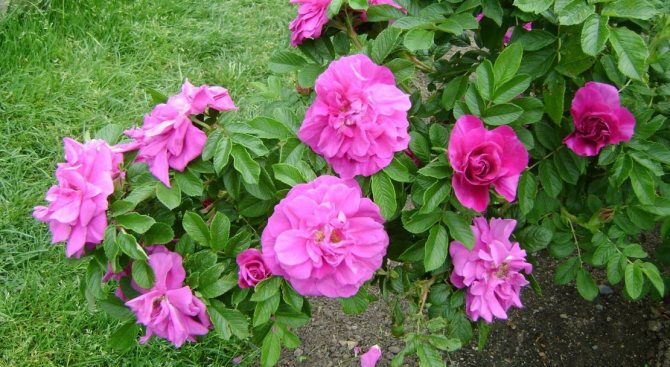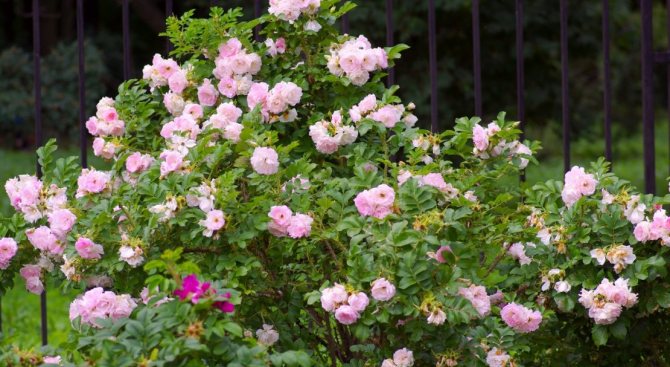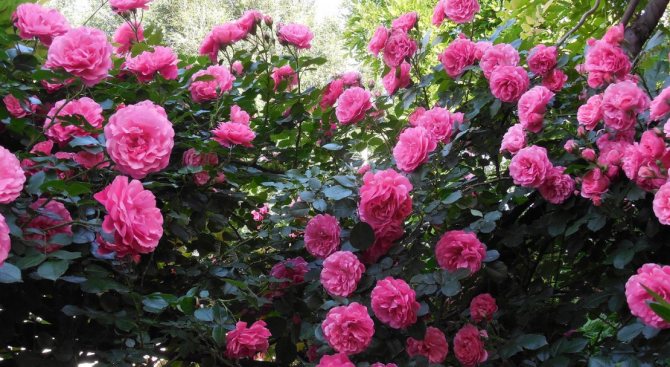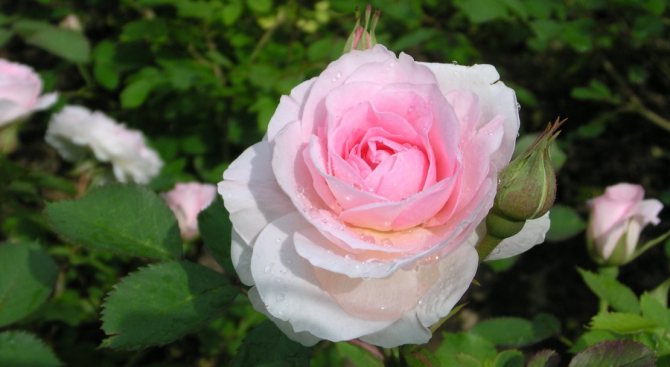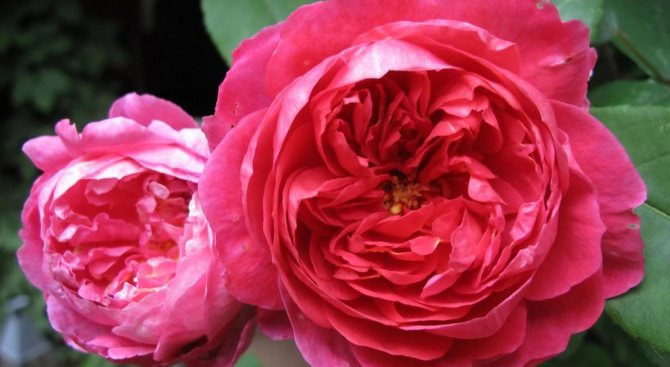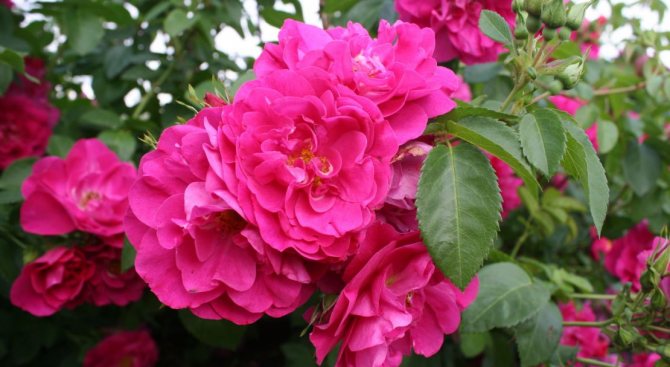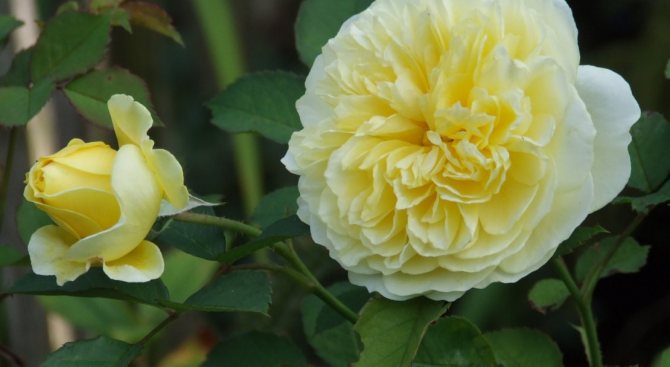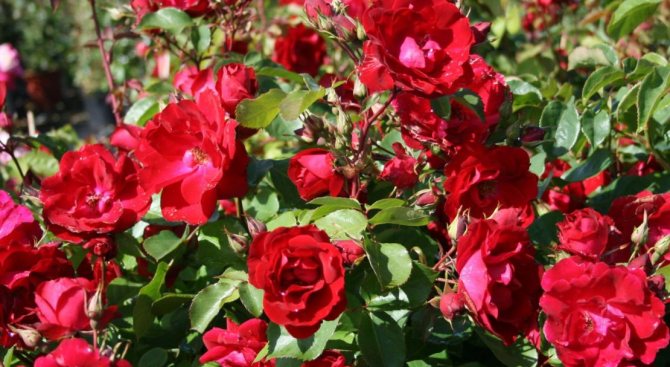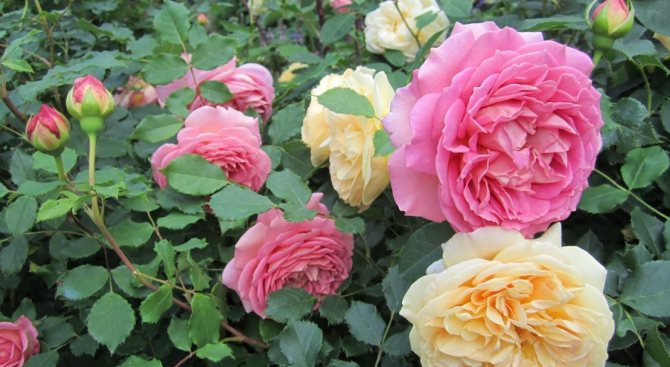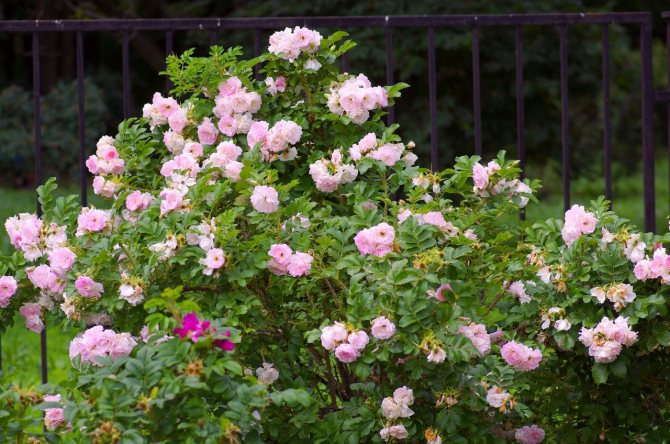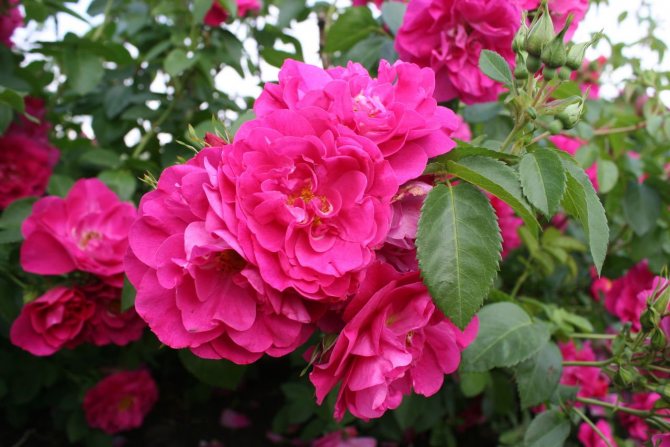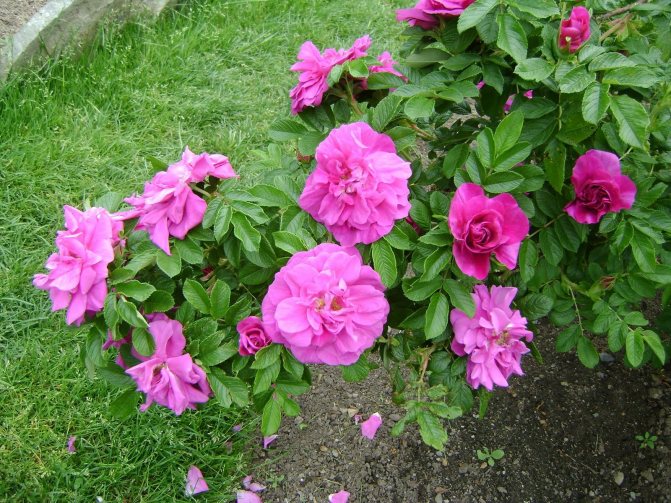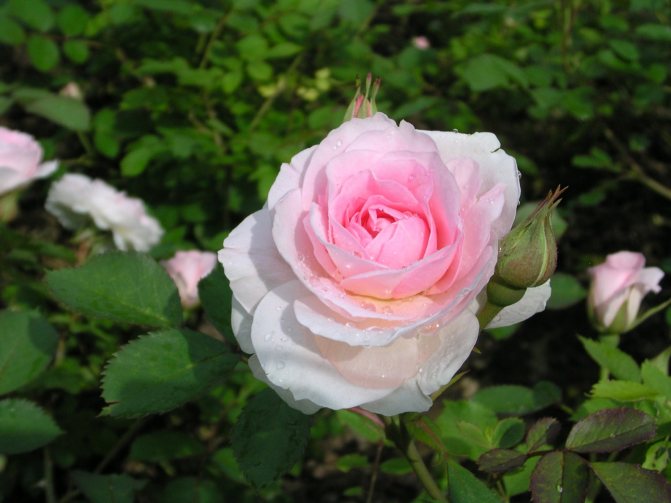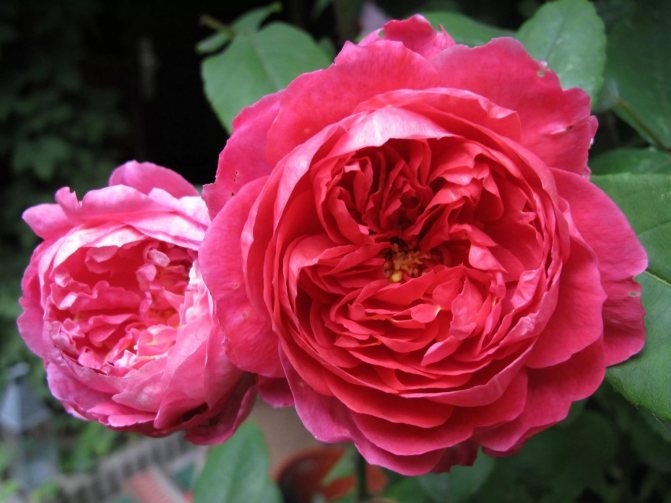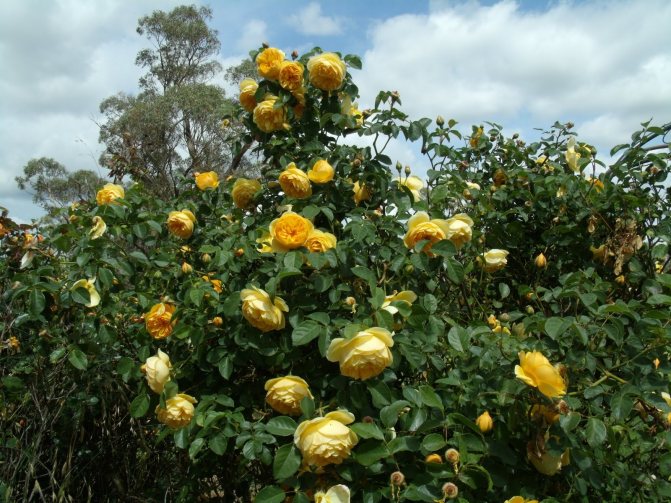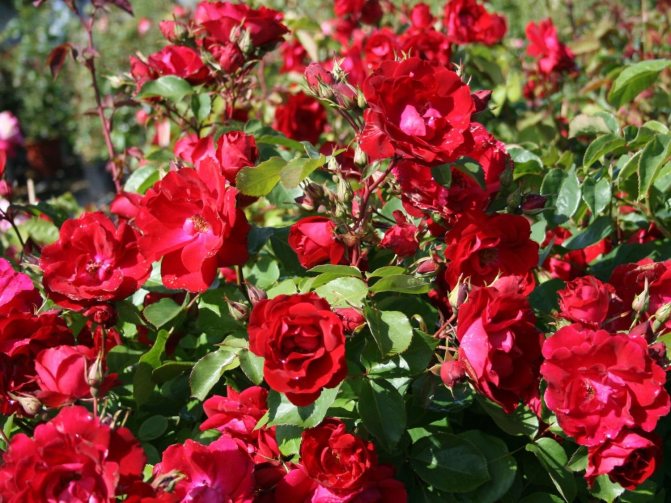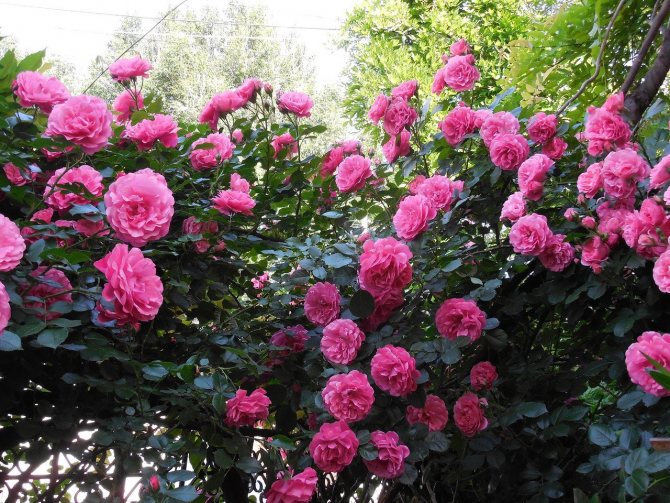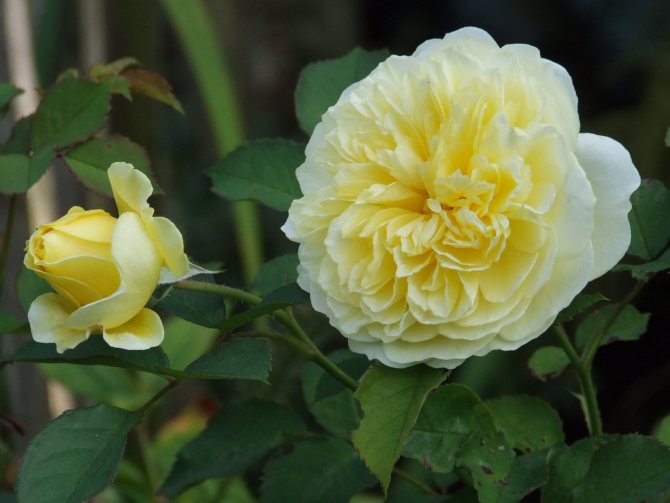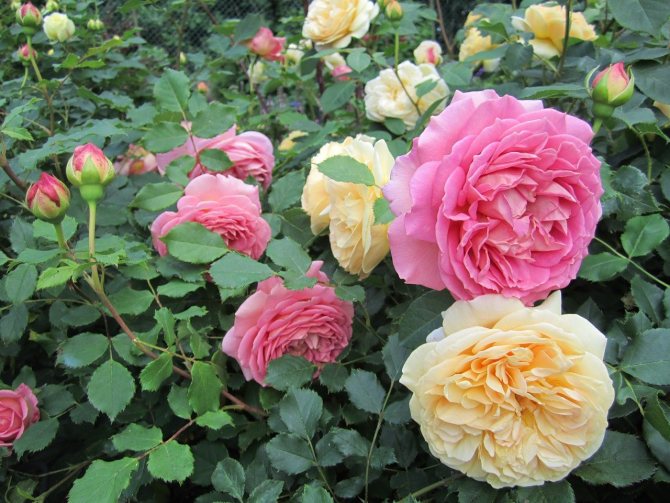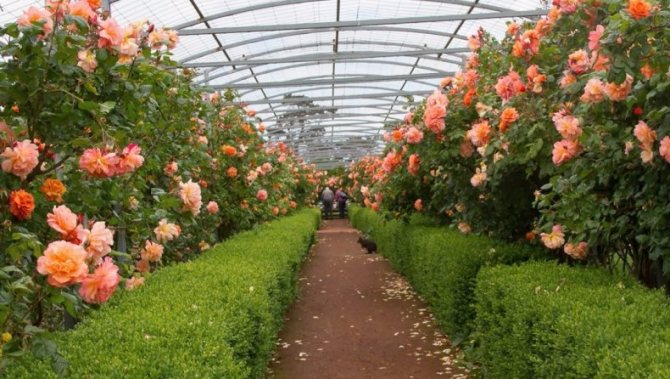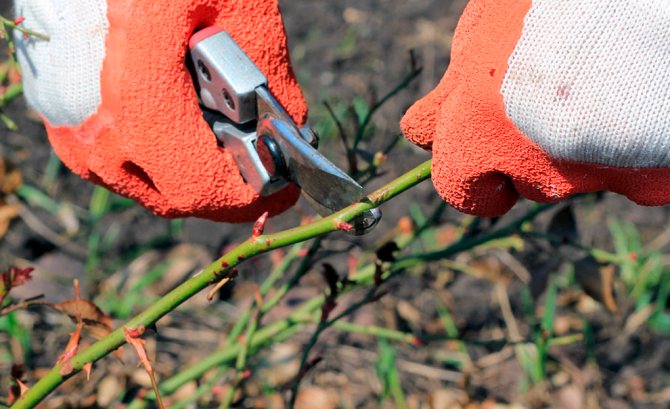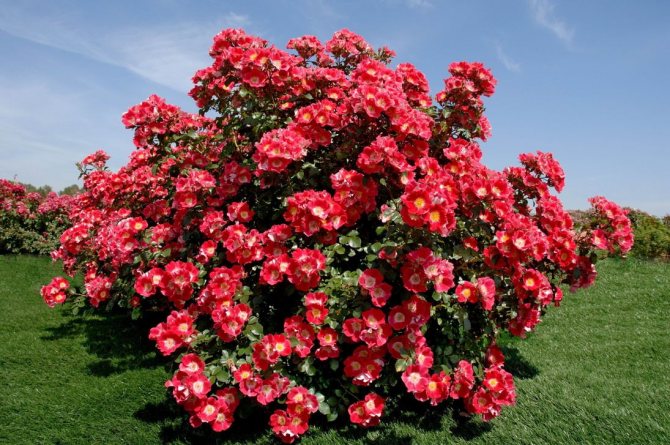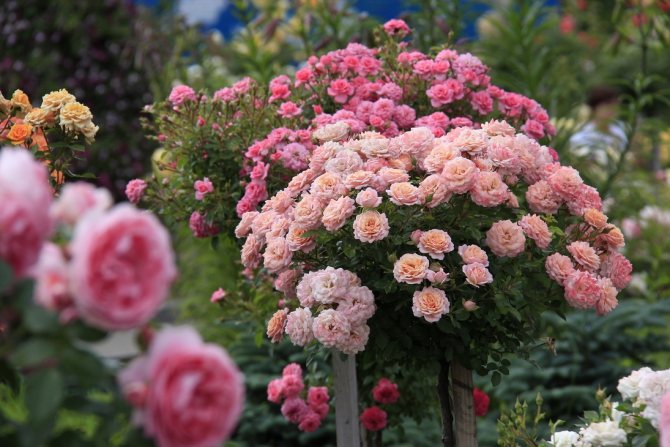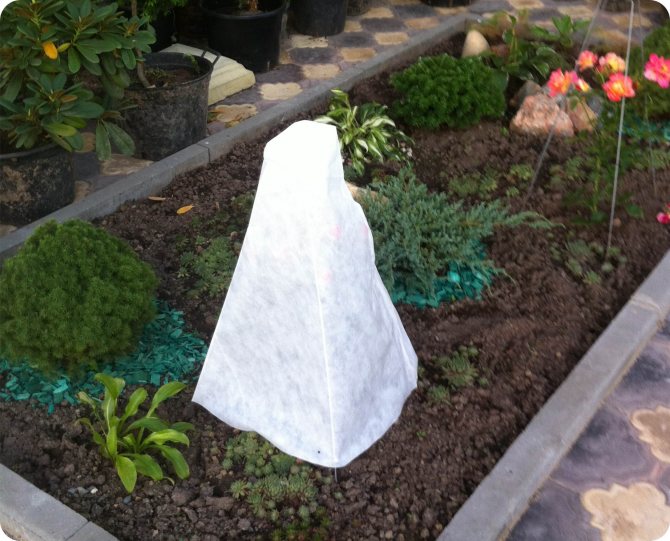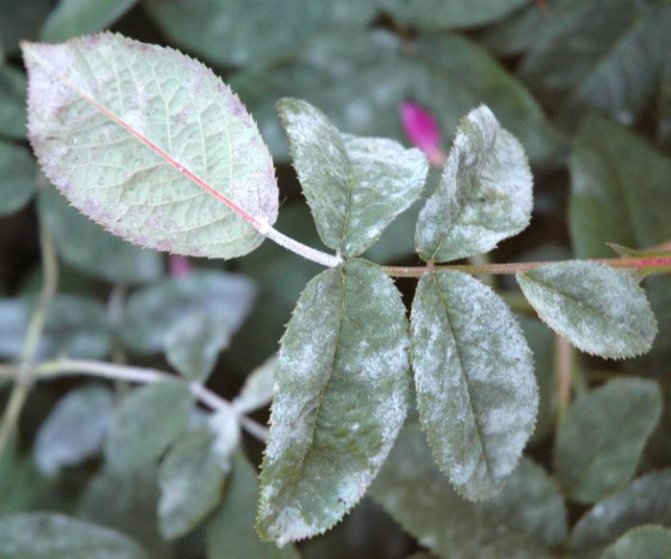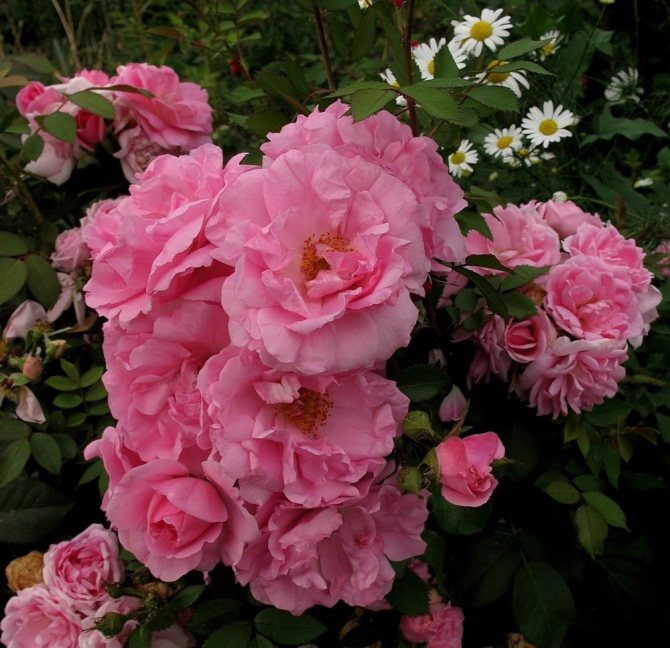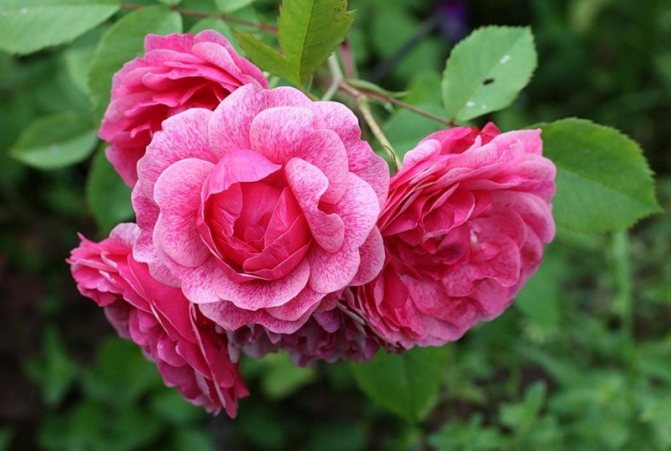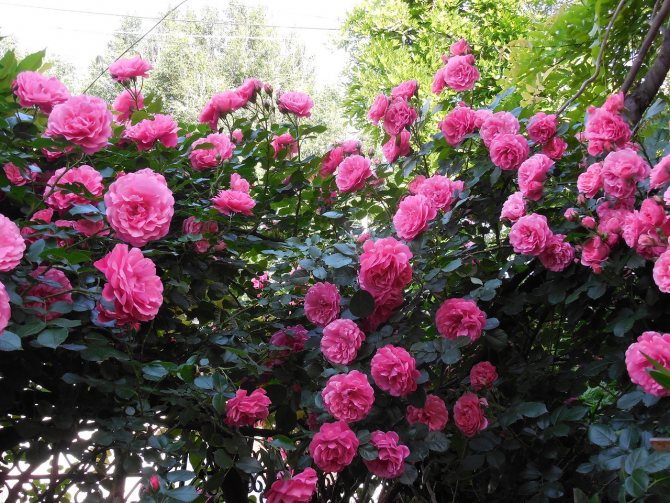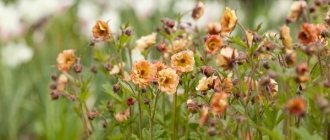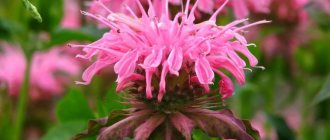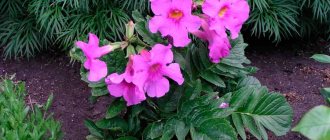Roses are a highly recognizable plant ideal for any garden, and come in a variety of shapes, from traditional shrubs and climbing plants to miniature containers. Some species bloom once a season, while others bloom all summer. They are distinguished by their tenderness, aroma and do not require special attention and care. The variety of colors and the multicolor of these colors cannot leave anyone indifferent!
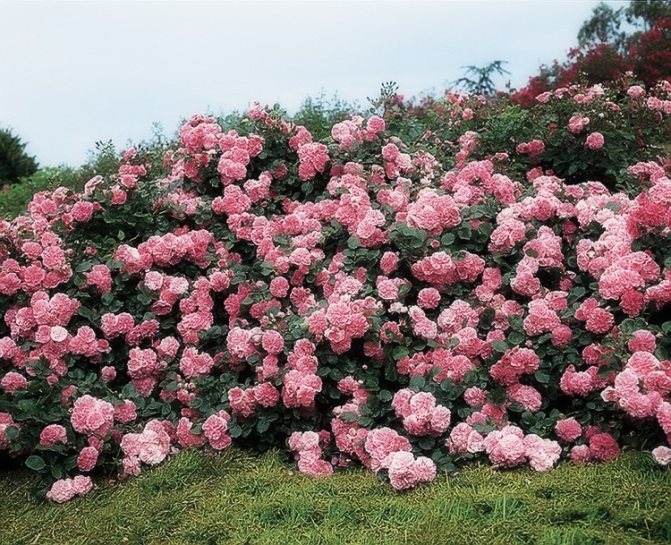
Description and features of park roses
Park roses are a group that brings together three main types of plants: decorative rose hips, modern hybrids and ancient roses. A common feature of all plants is their bush-shaped appearance and the ability to winter outdoors even at low temperatures.
To understand in detail what it is - park roses, consider their main characteristics:
- The height of different plant varieties can be from 1.5 m to 2.5 m.
- The root system is powerful, its length can be up to 2 m.
- The branches of the plant are covered with many sharp thorns.
- The foliage of the plant is dense, green. The leaves are small, oval in shape.
- The bloom is profuse, lasts 3-4 weeks and repeats every year from May to late June. Some varieties bloom again in August.
- Flowers consist of a large number of petals tightly pressed against each other.
- Roses range in color from white to bright purple. There are varieties with yellow and orange flowers.
- The flowers have a delicate and pleasant aroma.
- In place of the dried buds, fruits are formed. Depending on the variety, they are round or oval, and have a different color. In some varieties, the fruits are edible.
Did you know? The C rose is the smallest in the world. Its height is 12 cm, and the diameter of the flower is 1 cm.
Old and new varieties of these plants have been bred in various countries around the world.
The most beautiful varieties include park roses with the following names:
- Remi Martin, France;
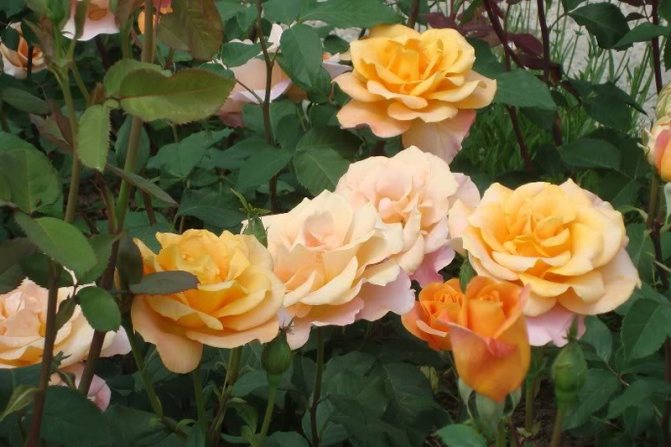

- Golden Celebration, England;
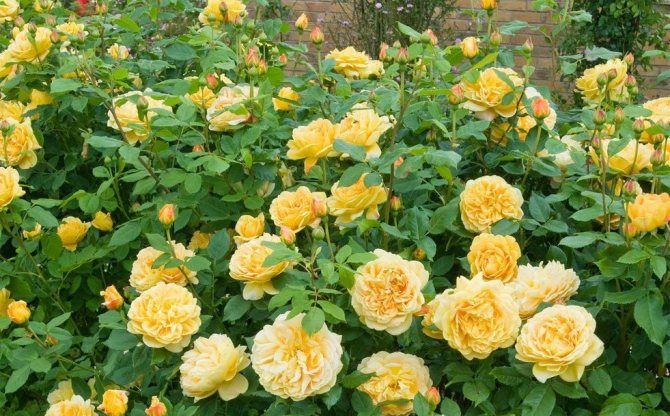

- Martin Frobisher, Canada;
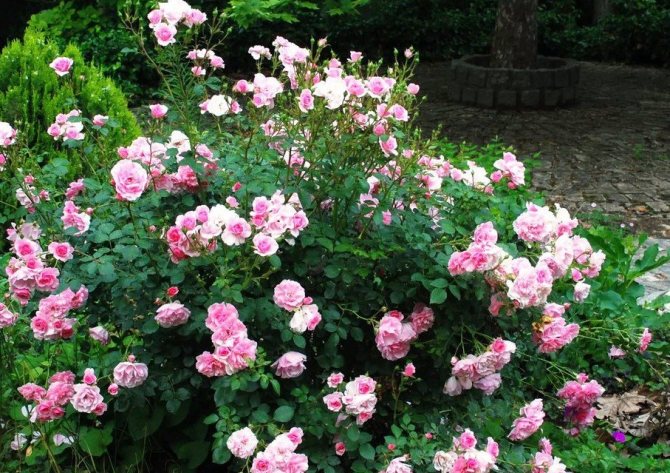

- Cardinal de Richelieu, France;


- John Franklin, Canada;
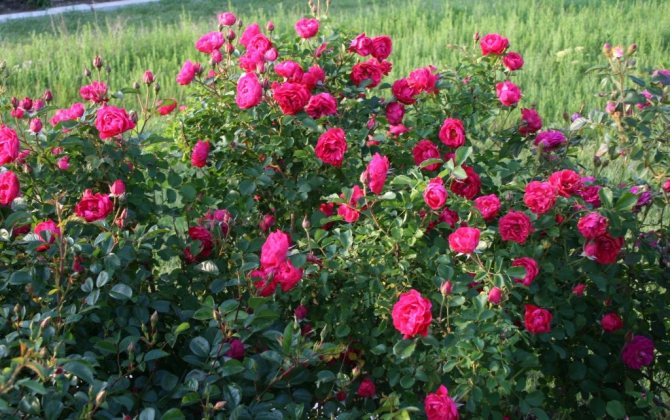

- Prairie Joy, Canada;
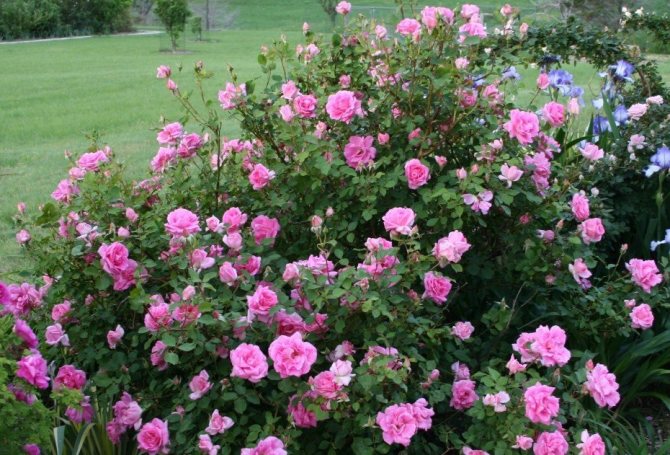

- Benjamin Britten, England;
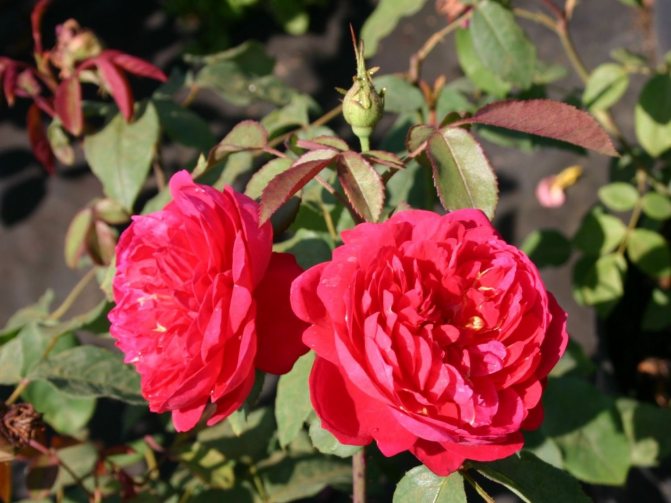

- Henry Kelsey, Canada;
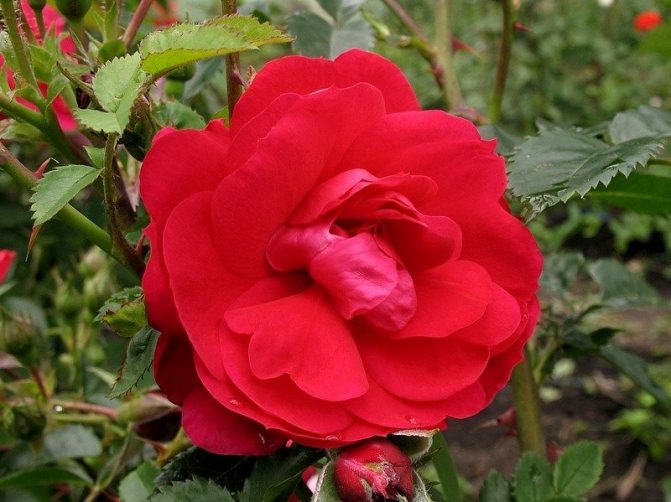

- Rose rugose (Rosa rugosa), England;
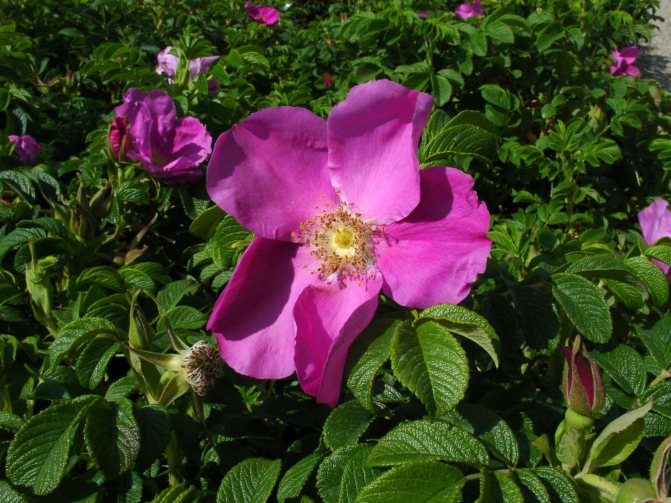

- Alexander MacKenzie, Canada;
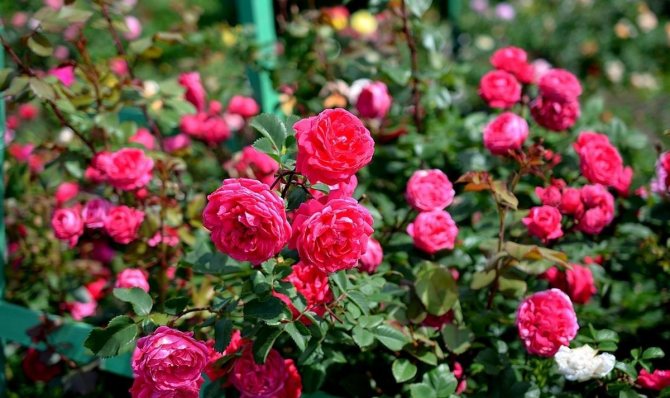

- Centifolia (Rosa centifolia), France;
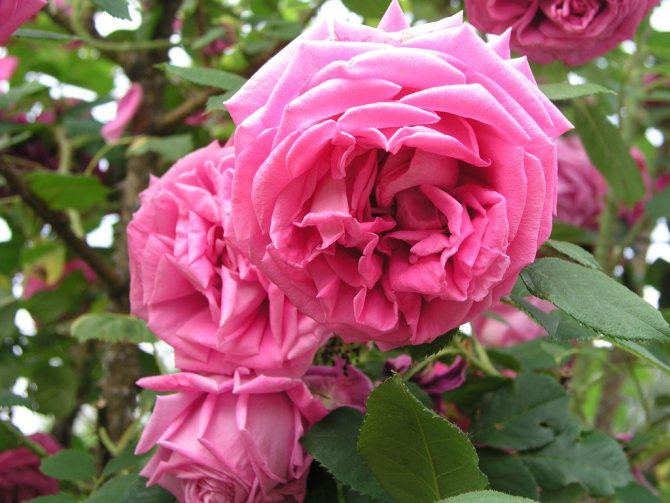

- Morden Blush, Canada;
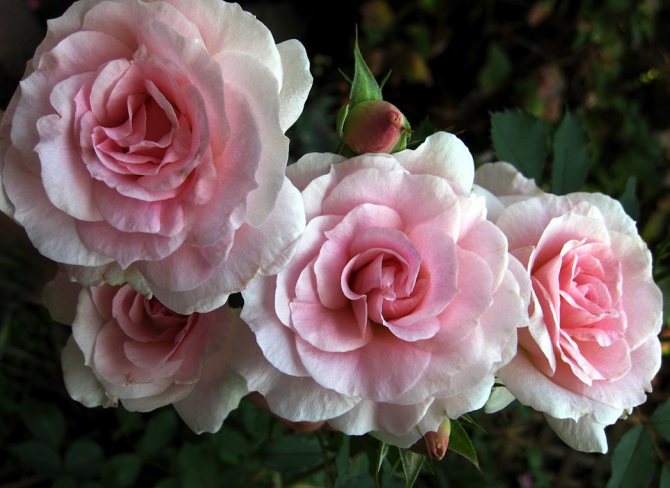

- Winchester Cathedral, England.
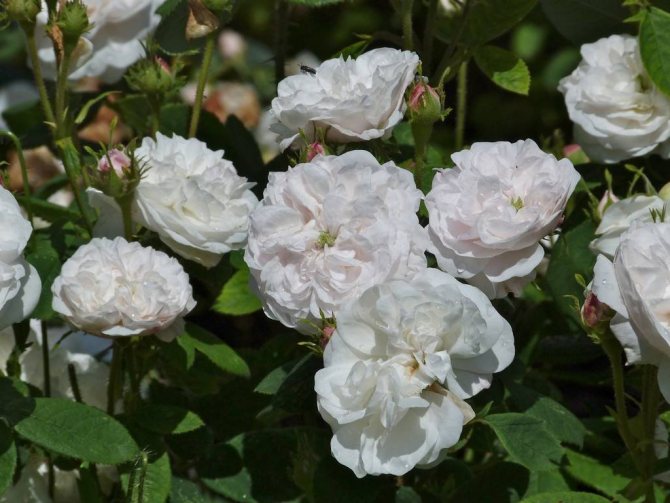

Description
The bush reaches one and a half meters. Buds appear early, blooms profusely and for a long time (more than a month). The color of flowers is usually in the range from white to deep purple
, orange or yellow colors are somewhat less common. In the photo below you can admire the beauty of terry park roses, one flower can consist of 150 petals, which is not inherent in any other type of roses.
Park roses love spacious plantings, as they grow not only in height, but also in width. In France and England, plants do not need shelter, but in Russia, most varieties of park roses wait out closed during the cold season. In the middle lane, you can leave open only species-specific roses close to wild ones, for example, gray and wrinkled rose, as well as species close to rose hips, but having double flowers.
Park roses are more unpretentious if bred in Canada
... Such varieties are frost-resistant and do not need shelter, provided that the site:
- located in a relatively calm area,
- does not have high ground waters,
- gets sunshine,
- is processed correctly.
However, when sheltered, Canadians provide more abundant flowering.
Varieties of French, English, German selection of park roses require bending and shelter, among them are old and modern bush roses.
Classification of park roses
There are many varieties of park roses. Some were known several centuries ago, while others were bred quite recently.
But according to the generally accepted classification, all these varieties can be divided into two types:
- once flowering - flowering is observed once a year in the time interval from May to June;
- re-blooming - can bloom in June and again in August, were artificially bred by breeders.
Important! Once flowering park roses are more resistant to cold weather and require the preservation of last year's shoots for the next flowering.
The re-flowering varieties are divided into three groups:
- frost-resistant rugoses (hybrids) - can be found in winter without shelter;
- cold-resistant Canadian roses - hibernate without shelter, if the winter is not too harsh, but in severe frosts they need protection;
- varieties with low frost resistance - necessarily require shelter for the cold season.
Planting flowers
Park roses can be planted individually or in groups. And you can form whole hedges from these flowers. Planting plants is not difficult, but it requires some additional work and adherence to the correct sequence of actions.
Optimal timing
These flowers grow outdoors, so they need to be planted during the warm season. You can start planting bushes from May and carry it out until mid-autumn.
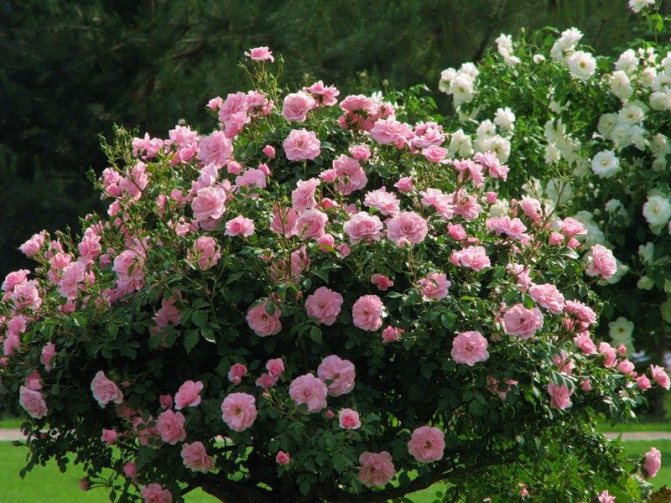

For good rooting and growth, it is better to plant plants in late September or even early October. In this case, they will have time to grow roots and will be stronger and more developed compared to flowers planted in spring.
Preparatory work
In order for the bushes to take root and take root better when planting on the site, you need to prepare the soil and the seedlings themselves.
Before planting plants, it is recommended to carry out several mandatory actions:
- a month before planting, dig up the soil on the site to a depth of about 60 cm;
- add mineral and organic fertilizers to the soil to enrich it with all the necessary nutrients;
- if it is impossible to immediately plant the seedlings, then their roots must be dipped in water or wrapped in a damp cloth to prevent them from drying out;
- 2 weeks before planting, dig holes in the soil with a diameter of 90 cm and a depth of about 70 cm. The recesses should be wide so that the straightened roots of the seedlings fit in them.
Gardeners also grow rose varieties such as:
Landing technology
After the plot and seedlings are prepared, you can proceed directly to planting flowers. This process is not difficult, but it requires some rules to be followed.
Step-by-step instructions for planting park roses are presented below:
- The distance between adjacent bushes in the same row should be 1–1.5 m, so that adult plants do not grow close to each other.
- The distance between rows of bushes should be at least 3 m.
- Mix the soil obtained by digging holes with manure.
- Pour a little of this mixture into each groove and pour well with water.
- Prune bruised and damaged roots of seedlings with pruning shears. Cut off the tips of the ground part of the shoots, leaving three eyes on each of them.
- Place the roots of the seedling in the hole, spread them out and sprinkle with soil. Tamp the soil around the plants well.
- Water the plants and spud them to a height of 20–25 cm.
- If planting is carried out in the fall, then mulch the soil around the bushes. Peat or chopped straw can be used as mulch.
Did you know? The oldest rose bush grows in the German town of Hildesheim near the cathedral. The plant is about 1000 years old.
If the bushes of plants are to form a hedge, then they are planted closer to each other.The distance between the rows is 50–70 cm, and between adjacent plants in the same row - up to 1 m.
The best varieties of floribunda roses for the Moscow region
Arthur Bell


The leading variety in the rating, which is recognized by gardeners as one of the best for the climatic conditions of the Moscow region. It was bred over 60 years ago in Northern Ireland. Among the main advantages: minimum care, long flowering, winter hardiness, absence of diseases and, of course, beautiful appearance. The shade of the buds is pale yellow. It creates a festive mood during the flowering period and contrasts well with the classic shades of roses.
The buds are large. Dissolving, they become lush semi-double flowers, consisting of 20 petals. The width of the bushes is 80 cm, the height is up to 1 meter. The leaves are dark green, large, with a shiny surface, resistant to pests and diseases. The smell is very rich, fruity. In terms of aroma intensity, it is ahead of other floribundas. Bloom lasts from June to November.
When landing, a calm place is chosen. According to reviews, the flowers persist even during the period of heavy prolonged rains. The frost resistance of the variety is up to - 28 °. It grows well not only in the middle lane, but also to the north. Roses are suitable for arranging flower beds, decorating individual areas of the site, they look luxurious both separately and in combination with other plants.
Leonardo da Vinci
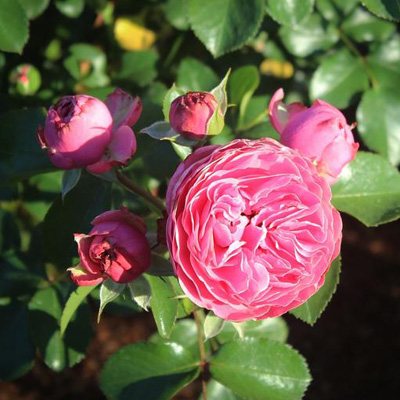

The variety, which took the second place in the ranking, belongs to the extensive floribunda plant group. It was selected 25 years ago and it was not for nothing that it got its name in honor of the great artist. A rose with a unique bud is a magnificent decoration of the site and very often becomes the main accent in the design. Terry flowers of a bright pink hue. The bush grows up to 100 cm in height. It is quite powerful and sturdy. The leaves are dark green with a glossy overflow.
The advantage is that the flowers do not fade under the influence of sunlight, while maintaining an intense shade. The smell is light, delicate, with a fruity note. In addition to its visual appeal, the variety is distinguished by its maximum resistance to diseases, prolonged rains, frosts. The main condition for a long life is draft protection. In combination with proper care, gardeners are guaranteed abundant and long-lasting flowering.
Leonardo da Vinci is universal. It can be planted with one bush, or you can form groups of other varieties. Roses look great on a flower bed or in a slender line, forming a "live" border. According to reviews, the flowers do not crumble, and the bush looks very neat until the end of the season. The variety does not require increased care, pests appear very rarely.
Features of growing and care
A park rose does not require complex and scrupulous care. It is able to withstand low air temperatures and is well pollinated by insects, and flower reproduction is not difficult.


Young rose bushes that have not reached the age of 3 years require the most careful care. They need strict adherence to the recommendations described below and require regular loosening of the soil. Let's take a closer look at the general recommendations for the care and cultivation of all park roses.
Location and optimal conditions
Plants can be grown in various conditions, but for a lush and regular flowering, you need to take into account the peculiarities of the location of the plot with flowers.
Important! If the soil for roses is sandy, peat and compost are added to it, and if it is clayey, sand, peat and compost are added.
Here are some guidelines for choosing a site for planting:
- plants need good lighting, therefore, it is better to plant them in open areas. Roses can grow in partial shade, but in this case the flowering will not be so abundant;
- you can not plant park roses near the trees. The roots of the bushes will not have enough nutrients for normal growth, since the trees will take most of the micronutrients from the ground;
- the soil should be of medium acidity;
- the area with plants should be protected from the wind, flowers grow poorly and bloom in a draft;
- it is impossible for groundwater to be closer than 1 m from the surface of the earth in an area with flowers - the roots of the bushes in this case will become waterlogged and rot;
- it is not recommended to plant park roses near other fragrant plantsso as not to mix flavors.
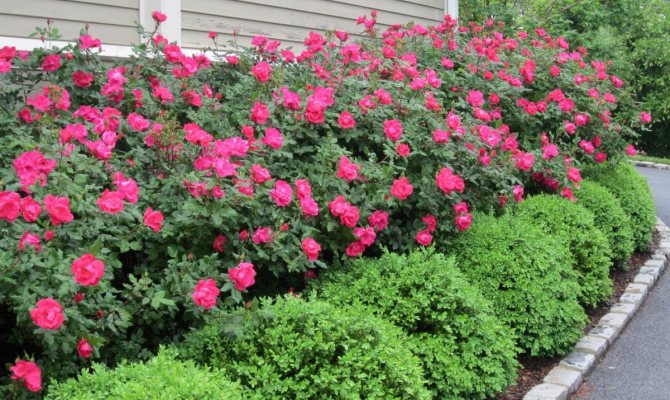

Watering and feeding
Plants tolerate drought better than too moist soil. But for normal development, it is necessary to water the bushes of park roses abundantly in spring and summer. During this period, plants spend a lot of energy on growth and flowering.
Did you know? Rose of the Chameleon variety, bred in Japan, changes the color of the petals throughout the day from bright red to white.
Consider the basic watering recommendations:
- watering should be done early in the morning or in the evening, when the sun is already sinking;
- if the weather is dry, you need to water park roses in the summer 2-3 times a week;
- for one bush you need to spend 1-2 buckets of water;
- during watering, you need to achieve deep soil moisture, surface watering will not provide the roots of flowers with the required amount of moisture;
- you need to water the plants at the root so that water does not get on the leaves and flowers;
- by the beginning of autumn, park roses are preparing for the winter dormant period, so in September you need to stop watering them.
Plants consume a large amount of nutrients from the soil, which they need for normal growth and abundant flowering. Therefore, the soil near the bushes must be constantly enriched with the necessary substances with the help of fertilizers. You need to apply top dressing throughout the entire period of growth and flowering.
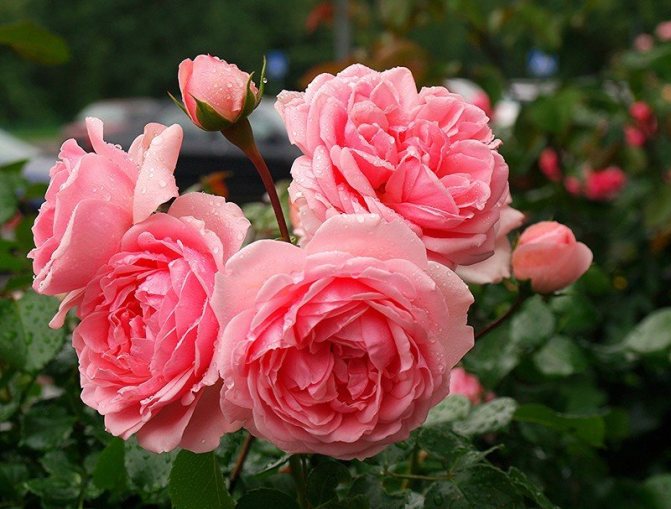

The basic rules for fertilizing park roses are presented below:
- for good growth and build-up of green mass in spring, plants are fed with manure and fertilizers containing iron, boron and magnesium;
- to strengthen the roots at the end of summer, fertilizers containing calcium, potassium and phosphorus are applied;
- in early autumn, the bushes are watered at the root with a liquid solution of superphosphate and potassium monophosphate;
- to enrich the soil with micronutrients, rotted compost is introduced under the plants in October.
You will be interested to know which varieties of roses are the most fragrant and fragrant, and which are the smallest.
Reproduction
Park roses are easy to propagate. This procedure is best done in the spring, but some preparatory steps need to be carried out in the fall. Consider the methods of propagation of park roses and their brief description.
- Layers. The lateral stems of the plant are tilted to the very ground and fixed in this position. From above, inclined shoots are sprinkled with earth for rooting. The branches are in this position for a whole year - until next spring. Then the rooted branches are carefully separated from the mother bush and transplanted to a permanent place.
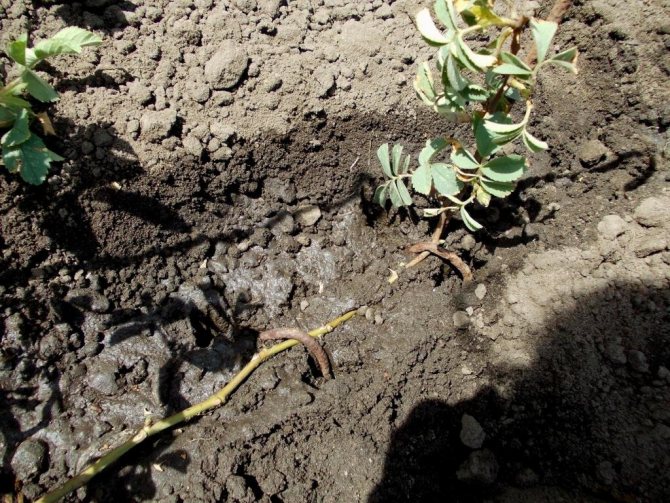

- Bygrowth. Park rose bushes constantly form young shoots. When the shoot reaches the age of 1 year, it is separated from the parent bush and planted separately. In this case, its stem must be shortened by one third.


- By dividing the bush. The procedure can be carried out both in spring and autumn. With the help of a pruner, a bush of park roses is divided into two parts. Each of them must have roots and at least one stem. One part of the bush is left in the same area, and the second is transplanted to another place.
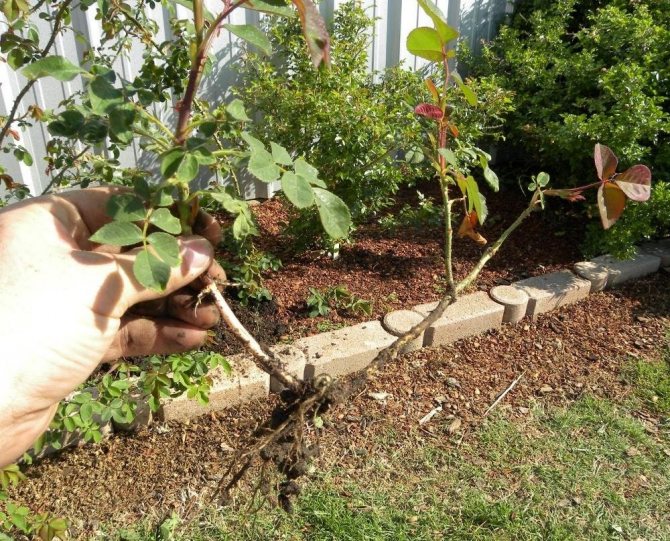

- Cuttings. For this propagation method, green or lignified cuttings are suitable. Green cuttings should be cut from the bush at the beginning of the flowering period, and lignified ones - in the fall. After cutting, they are buried in the sand for rooting, and in the spring they are transplanted to a permanent place.
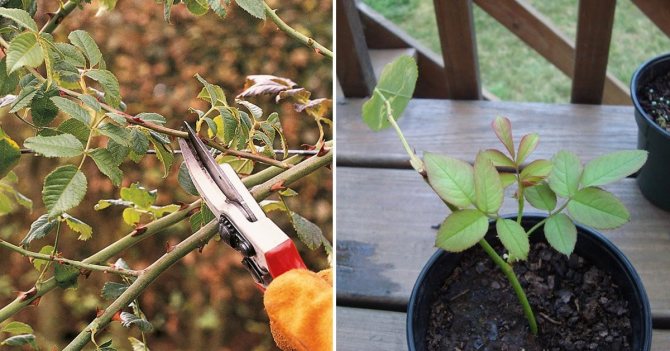

Pruning and covering roses for the winter
In order for the bushes to retain an attractive and blooming appearance, they need to be formally pruned annually.It will not only help give the bush a beautiful shape, but will also increase the number of buds during the flowering period. It is best to carry out this procedure in April.
Important! For the first time, pruning can be carried out only 2 years after planting the bushes.
Consider the basic rules for pruning a plant:
- you can remove damaged and dried branches as needed;
it is on the lignified branches that flowers are formed, therefore the number of such branches should be maximum;
- shoots must be cut so that at least 6 buds remain on them;
- if you want to rejuvenate a bush of park roses, then its old stems need to be cut off near the ground itself. In this case, they begin to grow rapidly;
- so that pruning does not harm the plant, all cut points must be carefully treated with oil paint.
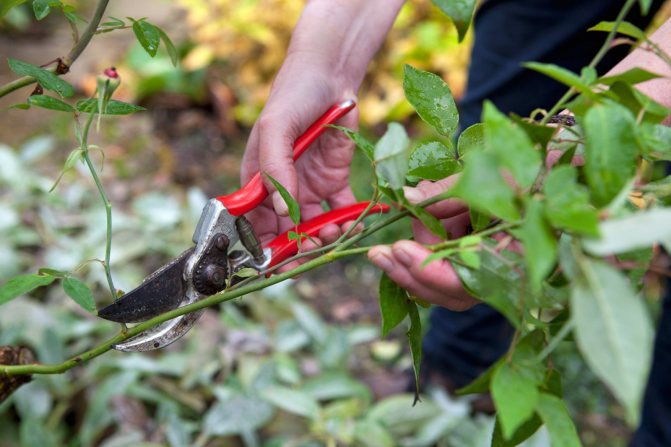

Some varieties of park roses can be grown even in regions with harsh climates. They can easily hibernate under a light shelter and not freeze. But young bushes are more susceptible to low temperatures, so you need to cover them especially carefully for the winter.
The basic rules for preparing park roses for the winter period are as follows:
- the bushes need to be covered with earth to a height of about 25 cm;
- branches should be slightly bent and wrapped in thick craft paper to protect them from low temperatures, wind and too bright spring sun;
- when the air temperature drops below –8 ° С, the bushes are covered with spruce branches (coniferous branches);
- if the air temperature is not too low (about 0 ° C), then an outlet must be made in the shelter for the bushes so that mold does not form on them.
Find out more about when and how to prune roses, as well as what are the rules for pruning roses for the winter.
Re-blooming
Among the most famous varieties, the following crops stand out:
A. Mackenzie scrub (Canada)
The bush is powerful, straight up to two meters, moderately thorny, the leaves consist of 7 leaves, matte structure. It blooms with soft pink-red double inflorescences, consisting of 40-50 petals. The size is medium, the shape resembles an old one, the flowers last for a long time, fading in the sun. A bush in a flowering outfit is very beautiful, but has no scent. But it pleases the eye all summer, rarely gets sick. Reproduction takes place by cuttings. Withstands frost up to 40 degrees, you can not cover. In the spring, pruning of dead shoots should be done, which does not affect abundant flowering. Provide more abundant flowering by covering the bush and bending down the shoots. Planting is best done in the background, since the plant is tall.
Fisherman's Friend® scrub (UK)
The flowers are violet-crimson or purple in color, densely double with a velvety effect, large. Usually solitary, persist up to 5 days, tolerate dampness well. They have a strong pleasant aroma. They are in perfect harmony with glossy, dark green slightly "wrinkled" beautiful leaves, which consist of 7 leaves. Shoots and even leaves on the back are covered with sharp thorns, so it is better not to approach the rose without gloves. The height of the bush is from 1 meter to 1.2. Needs disease prevention at the beginning of summer, in winter - in a shelter.
Moje Hammarberg Hybrid Rugosa (Sweden)
Flowers are large double, dark pink in color with a rich aroma. A single flower does not please the eye for long, rain can damage the petals. The leaves consist of 8 leaflets, moderately glossy, wrinkled. The spines are densely arranged. The height of the bush reaches 1.5 meters. It does not need shelter, since it is not prone to freezing. Does not require special care, diseases are absent, reproduction occurs by shoots.
Morden Centennial Scrub (Canada)
The height of the bush reaches 1.2 meters. Terry flowers with 45 petals, 8 cm in diameter, bright pink flowers are collected in inflorescences of 3 pieces. This rose smells weak. At the beginning of the opening of the bud, the flowers are very beautiful, but at the end they open the middle, in rare cases this does not happen.Abundant flowering occurs in June and August-September, after 5 days the flower withers. Flowers should be cut as the petals fly around; if this is not done, fruits will appear, which will not affect flowering in the best way.
The leaves consist of 7 leaves, large, matte structure, spines on the shoots are rare. Diseases are extremely rare. Planting and reproduction takes place by cuttings without much hassle. Withstands frosts up to 45 degrees, but if you cover and bend down, it will bloom more abundantly.
Prairie Joy scrub (Canada)
It grows in a tall and dense bush, reaching 1.5 meters. The leaves have a matte structure, young have a burgundy color, which turns into a dark green bluish hue, consist of 7 leaves. Not very prickly, as there are few thorns. It blooms throughout the summer with delicate pink double flowers of a beautiful shape, appearing in inflorescences. The flowers stay on the shoots for about 5 days, the rain affects them adversely, which is why decay is not excluded. They have a faint aroma. To stimulate re-flowering, wilted flowers are removed. The bush is not susceptible to disease. Planting is used for hedges. Withstands up to 40 degrees, but blooms more abundantly when covered and crouched.
Among park roses that bloom one-time, the most popular varieties are:
Centifolia (France)
During the month when flowering occurs, the pale pink color of the flowers turns almost white due to burnout. At first, the flower has a goblet shape, after which the stamens open to the eye. Falls off after about 4 days. It blooms very profusely, the aroma is felt several meters away. Often the buds are affected by gray rot, but due to the abundance of flowers, it is invisible. The leaves are matte, light green in color.
The thorns are small, infrequent. If you touch this park rose without gloves, splinters remain on the skin. Fruits are formed but not ripe. The bush reaches 1.5 meters. You do not need to cover, reproduction occurs by shoots. Planting is done along the fence, as it grows huge and does not require special care.
Poppius scrub
Flowers with a strong aroma, semi-double, medium-sized, pink in color. Leaves consist of 8 leaves, matte structure. The bush is very thorny. The height reaches more than 1.5 meters, does not need support. It blooms early during the crescent, with fruit setting, which, when ripe, becomes maroon in color. Frost-resistant, you don't need to cover. Reproduction occurs by shoots. Due to its size, this variety of park rose can be planted along the fence.
Pimpinellifolia plena
A creamy white rose with a strong aroma and semi-double flowers. Reaches a height of 1.5 meters, does not need support. It blooms once every 12 days with an ovary of fruits that mature to almost black. The leaves consist of 8 leaves of a matte structure. The bush is covered with frequent thorns. Frost-resistant variety, does not require shelter. Propagated by shoots. Landing is done along the fence.
Hybrid Rugosa (Canada)
This variety has beautiful, pink, double flowers with a strong aroma. Abundant flowering, within a month, even if the buds are affected by gray mold, which occurs in a rainy summer. Frosted slightly wrinkled leaves, shoots with dense thorns. It grows to almost 2 meters in length. She does not need shelter for the winter, she tolerates frosts. Reproduction occurs by shoots, planting is done along the fence.
For roses to please their appearance, you should know some of the nuances:
Beautiful park roses will delight you with abundant flowering for a long time, if you provide proper care, find a sunny place
with breathable soil.
Basically, the park rose is a cultivated rose hip.It grows as a magnificent powerful bush, attracting connoisseurs of lush flowering and fruiting. It is hardy and decorative. So, the object of our study is park rose: planting and care
behind a flower.
Do you know what park roses are? There is no such concept in the garden classification, nevertheless, this name is used in everyday life, however, what is meant by it depends on the climatic conditions. So, which roses are park roses in Russia?
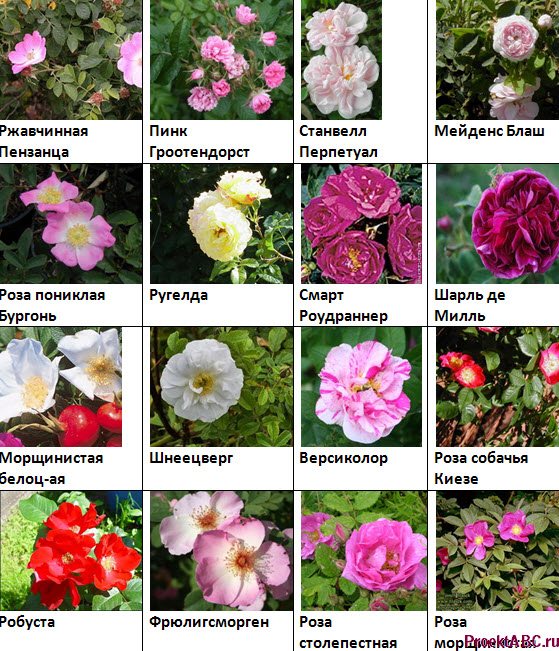

It should be noted that park roses will be a great addition to your summer cottage landscape design.
Prevention and control of pests and diseases
Park roses are grown outdoors, so attention must be paid to preventing the appearance of possible diseases and pests.
Most often, when growing plants, the following problems arise:
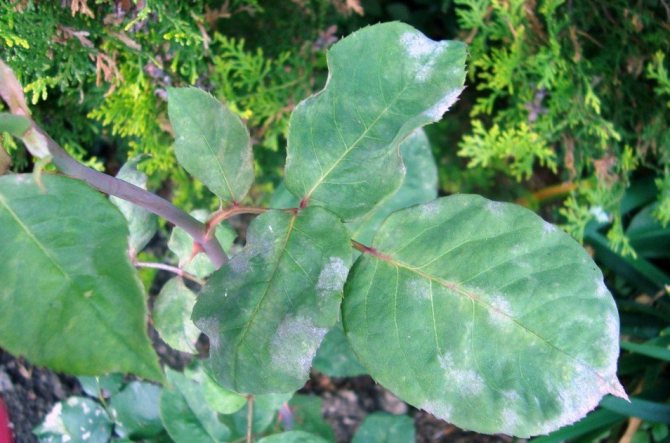

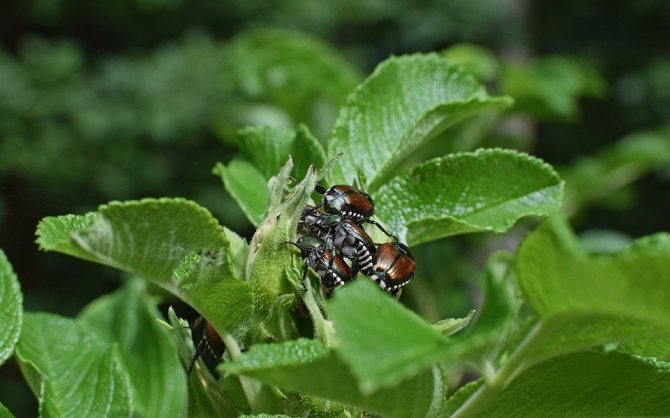

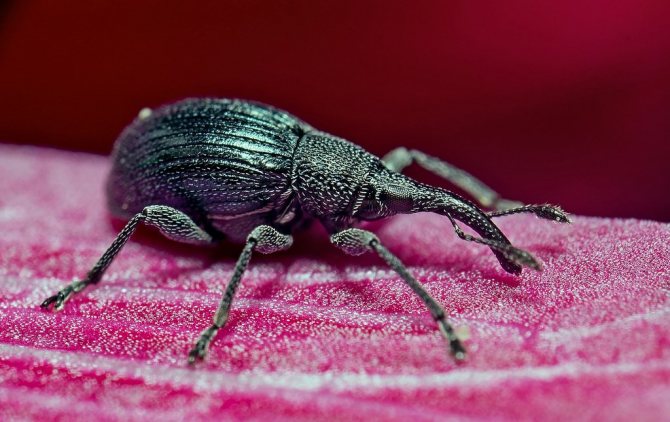

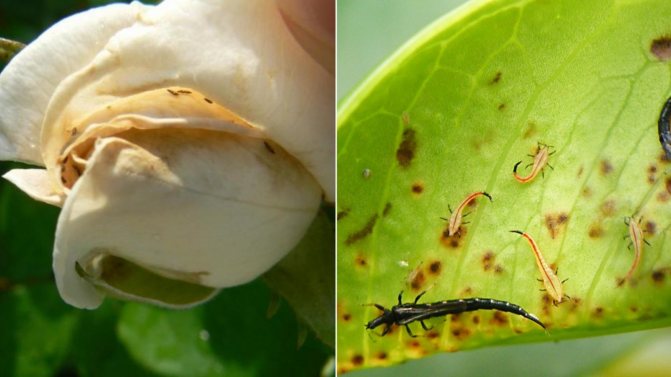

The best varieties of Austin roses for the Moscow region
Crown Princess Margaret
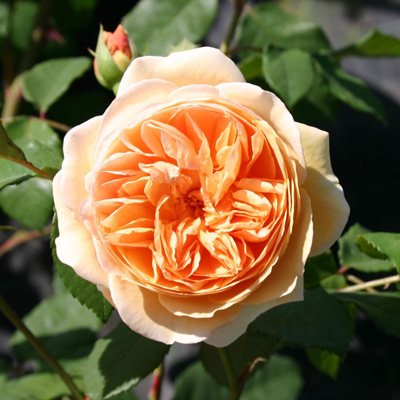

An ornamental plant, recognized by gardeners and experts as the best Austin rose variety for growing in the Moscow region, was bred in 1999 and named after the granddaughter of the Queen of Sweden, who was fond of floriculture. It becomes the first in this rating category. Rose belongs to the most hardy and healthy group and can grow in more severe conditions than the average strip of Russia. The buds are large, opening into voluminous flowers of an apricot-orange hue. They are densely double and have up to 120 petals in one bowl. The bush reaches 2 meters in height. There are practically no thorns on the stem.
The aroma is rich, strong, with a barely perceptible fruity note. The variety is versatile and suitable for various purposes. It can be a single planting or a composition of several ornamental flowers and shrubs. The rose is a wonderful cut view from which magnificent bouquets are made.
According to the respondents, the variety is ideal for the climatic conditions of the Moscow region. It does not require special conditions, enhanced care. It is resistant to disease, rain, frost. It showed itself excellently both in increased heat and during periods of abnormally low temperatures.
Alexandra Kent
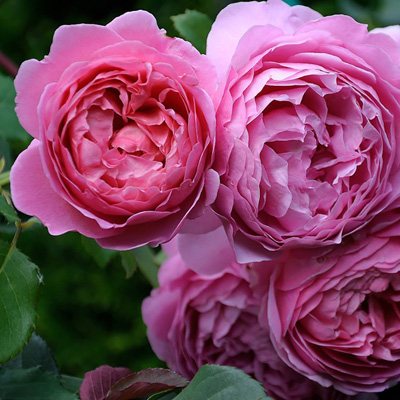

Another representative of English breeding is included in our rating. Extraordinarily beautiful, double flowers are striking in their magnificence. The buds open into a cupped shape. The inner petals are more intense pink than the outer ones. An adult shrub reaches a height of 90 cm and a width of 60 cm. An interesting aroma distinguishes this variety from others.At the beginning of flowering, it is fresh, light, by the middle of summer it becomes lemon, and ends with a barely perceptible smell of black currant.
Leaves of a dark green shade, medium size, with a slight gloss. The variety is recommended to be planted in groups of 4-6 pieces per square meter. They create a lush bush that adorns any landscape composition.
Rose belongs to the highest level of resistance to powdery mildew and black spot. She is not afraid of harsh winters, flowers do not deteriorate during intense rains, and special care is not required. Continuous flowering allows you to admire the voluminous bowls for a long time, while the appearance is always neat: the flowers do not lose their shape, the petals do not crumble, do not fade. Gardeners near Moscow rated this variety as "excellent" and consider it one of the most adapted to our climate with pronounced seasons.
Attention! This rating is subjective and is not an advertisement and does not serve as a purchase guide. Before buying, you need to consult with a specialist.
Park roses are one of the best varieties that can perfectly decorate any garden plot, not only in the southern regions, but also in central Russia, as well as in the Moscow region. Fairly harsh winters, not always warm and dry summers - in such conditions, not all varieties of ordinary roses can be grown, but among the park there are many varieties adapted to such conditions.
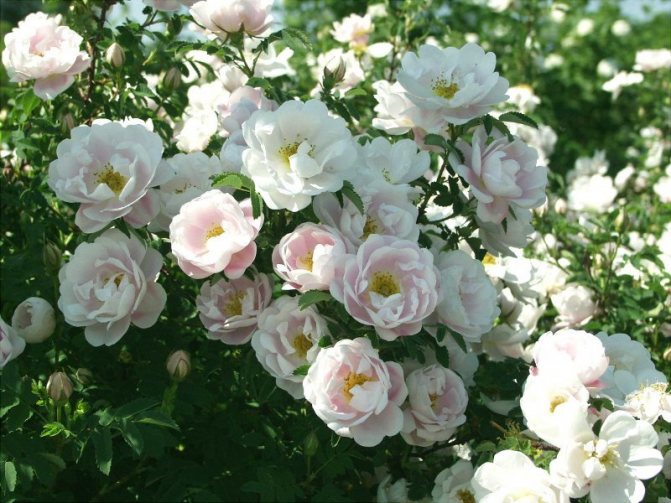

Park roses are one of the best varieties that can perfectly decorate any garden area.
In addition, the winter hardiness of many of these garden and park bushes "queen of flowers" is so high that these plants can not be covered during the cold season. therefore park roses, like some other flowering shrubs that do not require shelter for the winter, so actively planted in many garden plots of central regions, in the middle zone of our country, including in the Moscow region.
Use in landscape design
Park roses are used for vertical landscaping of the area, and the variety of colors allows you to create colorful flower arrangements with a unique delicate aroma. Often, park rose bushes are planted close to each other in a checkerboard pattern to form a hedge.
Did you know? The largest rose in the world - Lady Banks, has a trunk girth of 3.7 m and grows in a cemetery in Tombstone (Arizona, USA).
On small-sized areas, single-planted bushes look very beautiful. With the help of pruning, they can be given a lush and neat shape, and a regular green lawn can be made around the plants.
Park roses will decorate any area and will not require much time and effort to care for. In order for the bushes to annually please with abundant flowering and lush green mass, it is enough to follow the simple growing recommendations described in this article.
The best ground cover varieties of roses for the Moscow region
Hello


The variety included in our rating is often referred to as the purple carpet of flowers. It really covers large areas and decorates the landscape in parks and gardens in a short time. The bud, when opened, forms a bowl shape. The color from deep purple gradually turns into garnet. One bud contains up to 125 petals. The bush is compact, strong, maximum height - 65 cm, width - 110 cm. Leaves are bright green, shiny.
Flowering continues until late autumn, it is abundant, continuous. The shade of the buds becomes cherry by October. The aroma is "tasty", delicate, persistent. No special conditions for boarding are required. The bush takes root well in any part of the garden. It looks good on both large lawns and small flower beds.
According to gardeners, this is one of the best hardy varieties in its group. With it, you can quickly equip the garden, creating bright accents, while no extra care is needed.The variety can withstand low temperatures, rainy weather, disease resistant. Many noted that the bushes really look like a bright, beautiful carpet due to their abundant flowering and are admired by both households and guests.
Sea foam
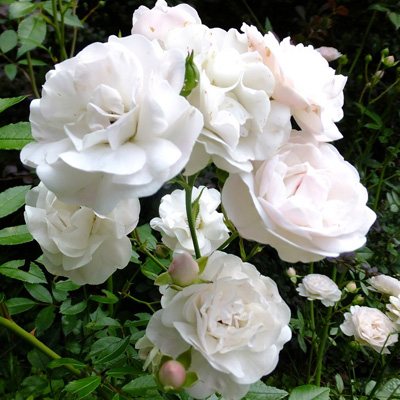

Another particular noteworthy variety is included in our rating. It forms a voluminous spreading bush, reaching a height of 100 cm. In width, it can cover an area of up to 1.5 meters. Roses bloom continuously from June until the first frost. The buds are pale cream or pearl white. Terry petals. The foliage is small, dark green. It is a versatile variety that is used in a variety of compositions and combinations.
It is recognized as one of the most abundantly blooming ground cover roses, where the mass of flowers overlaps the green foliage. The plant loves sunny places without strong wind, but with good air permeability. Having chosen such a place, fast growth, a safe wintering and the absence of diseases are guaranteed.
According to reviews, the rose forms a voluminous floral carpet, which becomes a decorative decoration of alpine hills, flower beds. It looks spectacular in hanging gardens, pots, pots. The variety is used for the decoration of borders, zoning of plots. Due to the powerful root system, the bushes are used to strengthen the slopes. Gardeners of the Moscow region recommend paying attention to this variety and making sure not only of its beautiful long flowering, but also of optimal suitability for the climate of the middle zone.

